Daisy Veerasingham Is of Sri Lankan Descent
N.Y. Times Flunks Native Journalists’ Test:
Meanwhile, Pew Study Omits Indigenous Entirely
Free Newspapers Hit by COVID, Too
Arizona Republic Revamps Crime Coverage
Short Takes: Byron Allen; U.S. entry for Afghan journalists; Fox Business host won’t book Black congressman; Jim Brady and Heidi Barker; Brent Jones; Telemundo expansion; joint African effort at investigative reporting.
Homepage photo: Reception area of AP global headquarters. (Credit: Eric Laignel/officelovin.com)
Support Journal-isms
Daisy Veerasingham Is of Sri Lankan Descent
The Associated Press Tuesday named Daisy Veerasingham (pronounced Veer-uh-SING-ham), a first-generation British national of Sri Lankan descent, as its new president and CEO, effective next Jan. 1. Veerasingham, 51, is the first woman, first person of color and first international citizen to lead the news cooperative.
“Veerasingham, AP’s executive vice president and chief operating officer, succeeds retiring AP President and CEO Gary Pruitt to become the 14th leader of the AP in its 175-year history,” the announcement said.
“Pruitt, 64, will remain in the role through the end of the year.”
As David Bauder noted in his AP report, “Veerasingham worked in marketing jobs at LexisNexis and the Financial Times before joining AP. A trained lawyer, she has not worked as a journalist.”
Katie Robertson added for The New York Times, “The A.P., which employs several thousand journalists reporting from 250 bureaus around the world, is interviewing candidates for executive editor, its top journalism job. Sally Buzbee left that post in May to succeed Martin Baron as the executive editor of The Washington Post.
“ ‘We’ve got really interesting candidates,’ Ms. Veerasingham said, ‘and we would hope to be able to make an appointment within the next month or so.’ “
Tha AP said in its announcement, “During her 17 years at AP, Veerasingham has grown revenue, diversified the news agency’s customer base – especially internationally – and introduced new business models. She also led the transformation of AP’s video business, making it fully digital-capable and market competitive, with a focus on multichannel live video delivery.”
When she was promoted to chief operating officer in February, Pruitt told the staff that she had guided the news organization’s revenue operations through the pandemic’s challenging circumstances “masterfully.”
Veerasingham has rarely been in the news. However, in May, Edward Helmore of the Guardian reported that “Management at the Associated Press have told staff that they stand behind their decision to fire newly hired reporter Emily Wilder who was targeted by a Republican smear campaign regarding her pro-Palestinian advocacy while a student.” The firing “has triggered widespread internal unrest at the AP and also external criticism of its actions.”
Veerasingham told the staff then “that the AP stood by its decision to axe Wilder but admitted it could have been handled better. ‘I want to reinforce we stand by our decision. It has been an extremely difficult decision to make. No one would deny that we didn’t make mistakes in the process and that we wouldn’t have done things differently,’ she said.”
Veerasingham said in Tuesday’s release, “The importance of AP as an unbiased, factual news source cannot be overstated – our journalism reaches more than half the world’s population every day. I am thrilled to take the helm of this deeply respected news organization and work with colleagues who do extraordinary work every day in support of our mission. Gary has been a true champion of mine along the way, and I sincerely appreciate his support.”
N.Y. Times Flunks Native Journalists’ Test
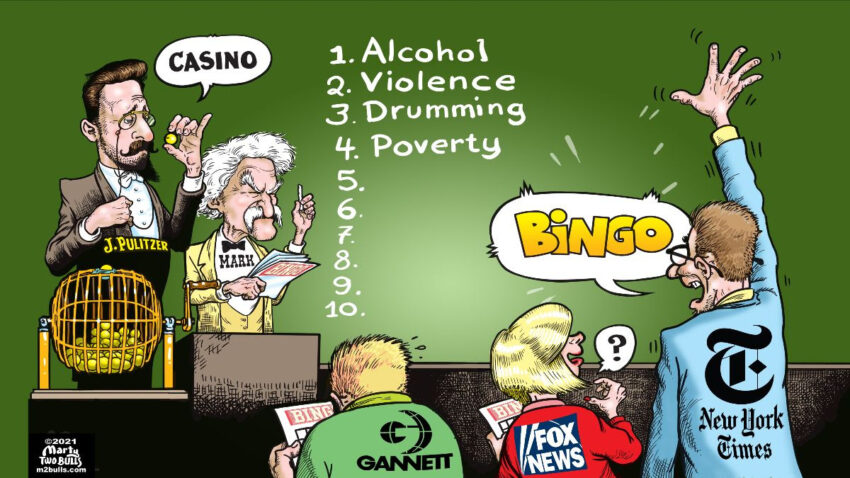
Meanwhile, Pew Study Omits Indigenous Entirely
An analysis of New York Times’ Indigenous affairs coverage from 2015 to 2021 found that half the stories used stereotypes, the Native American Journalists Association announced Monday.
Separately, Mark Trahant, editor of Indian Country Today, took the Pew Research Center to task over an omission in its recently released “State of the Media 2021.”
“Indigenous media? Nothing. Not a word about how hard it is to get data (true enough). Nor any reflection in any of the documents that we even exist. Not even an asterisk,” Trahant wrote in a commentary accompanying a fund-raising appeal.
Trahant published a response from Pew that said the research group promises to do better.
NAJA’s “2021 Media Spotlight Report,” based on an analysis by Sarah Liese (Navajo/Chippewa/Cree), and Dr. Victoria LaPoe (Cherokee), master’s students in the Scripps Journalism School at Ohio University, used NAJA’s “BINGO Card” [PDF] as a guide to identify stereotyping.
The report said, “The BINGO card has 14 key terms commonly found in news stories that display a limited knowledge of Indigenous communities. The most frequently used terms and ideas that appeared in the 2021 Media Spotlight Report on the New York Times were ‘violence,’ ‘vanishing culture,’ ‘ancestors,’ ‘poverty,’ and ‘reservation.’ “
It continued, “The more articles published in a year, the more the New York Times bingoed and 2020 had the highest number of cliched articles. That year also saw the highest number of Indigenous journalists published by the NYT, however, the majority of those articles were opinion pieces.”
The report also said, ” One solution is to employ multiple Indigenous journalists [as] reporter and editor, and [in] management positions. Another solution is to create a healthy environment for the reporter and editor to thrive.
“These two actions will promote more thoughtful and veracious storytelling and disperse the weighty responsibility of deciding what is the best way to report on Indigenous communities, as there are over 570 tribal nations in the United States alone and Indigenous people and communities are not monolithic.
“Utilizing more Indigenous sources is another way to ensure that their voices are present in the story, while reducing the notion that Native Americans remain in the past. When in doubt, consulting an Indigenous expert and referencing the NAJA Bingo Card are reliable resources to minimize harm.”
A spokesperson for the Times did not respond to a request for comment, but some Native journalists have cited good work by the news organization.
In 2018, Graham Lee Brewer, a contributing editor at High Country News, noted “racially offensive pieces like the obituary the paper ran for Dennis Banks, a founding member of the American Indian Movement, which drew attention to Banks’ ‘high cheekbones’ and had a headline calling him a member of the ‘country’s oldest minority,’ but noted that “Julie Turkewitz, who was recently promoted to the Times’ national desk, has consistently done thoughtful work from Indian Country, even giving Native writers their own platform to talk about Thanksgiving. The Times’ coverage of an Indigenous roller derby team was also very well done.”
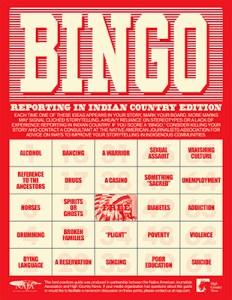
The Pew “State of the News Media (Project)” that drew Trahant’s comments was released in stages.
The “Hispanic and Black News Media Fact Sheet,” issued July 27, found that “While newspapers aimed at both of these groups have recently had audience declines, Univision and Telemundo have fared better with both network and local television audiences.”
It also said, “However, few of those newspapers, or of those listed as members of the National Newspaper Publishers Association (the Black Press trade association), have regularly audited circulation figures, making it difficult to acquire audience figures for the sector as a whole.”
“There are, however, 15 Black-oriented newspapers with recently reported circulation data. Among the eight papers with data for both 2020 and 2019, five saw their circulation drop by at least 10%, with the largest drop being 40% for the St. Louis American. This is in addition to the number of newspapers whose circulation is no longer available from the main auditing companies, including the Baltimore and Washington Afro-American, founded in 1892, and the Dallas Weekly, founded in 1954. . . .
“In the absence of abundant audience or financial data, survey data can shine some light on how Black Americans engage with the news. Black Americans are more likely than others to prefer to get their news on television, and are more likely than any other group to follow local news very closely.”
Trahant wrote that he tweeted his disappointment with the absence of Native numbers (Pew cited an absence of data on Asian American media.)
“Pew’s Senior Communications Manager Rachel Weisel emailed a response. She wrote:
“ ‘We also want to acknowledge your feeling of deflation and let you know that Pew Research Center is committed to expanding our research on race and ethnicity. We have recently centralized this work under a single strategy with the goal of studying different populations’ unique experiences and attitudes comprehensively. We hope to do more research on Native Americans in the future, in addition to research on other groups. Though it will take us some time to do this rigorously, we are committed to studying the full spectrum of the American experience.’ “
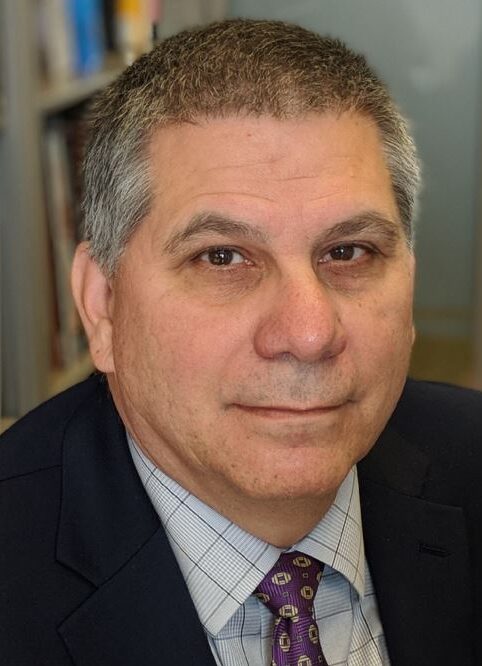 Trahant (pictured) replied, “That mission is more important than it has ever been because the country is changing so fast (something I have been saying for two decades now). As long as the data does not include the larger story of the media there is an error of omission and is therefore inaccurate.
Trahant (pictured) replied, “That mission is more important than it has ever been because the country is changing so fast (something I have been saying for two decades now). As long as the data does not include the larger story of the media there is an error of omission and is therefore inaccurate.
“I am going to be all wonky here, but in 1947 a group of scholars, the Hutchins Commission, studied the relationship between the news media and democracy. One of the key points: Facts are not enough. Context has to be a part of the story. Without that context ‘an isolated fact, however accurate in itself, may be misleading and, in effect, untrue.’
“Any story about media today must include the context of news enterprises like ICT because our narrative is so different from what some call ‘mainstream media.’ Indeed, I would argue we are now the mainstream media.”
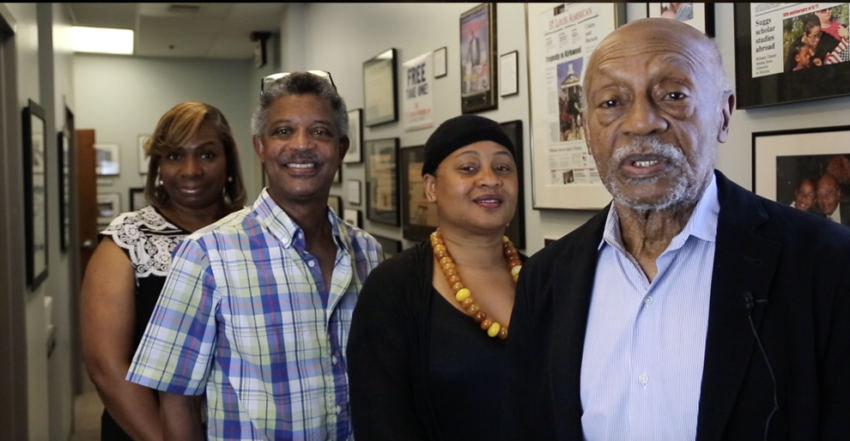
Free Newspapers Hit by COVID, Too
It was just in June that the St. Louis American won 10 national awards at the virtual 2021 Messenger Awards, bestowed by the National Newspaper Publishers Association, trade organization for Black-press publishers. The honors included the first-place John Russwurm Pinnacle Award.
Then, in July, the Pew Research Center, in its “Hispanic and Black News Media Fact Sheet,” reported that the free-circulation American sustained the largest circulation drop — 40 percent — among the eight African American newspapers with data for both 2020 and 2019.
Kevin Jones, the American’s operation manager, told Journal-isms Monday that COVID was partly to blame.
“We briefly dropped our circulation (which is free) for several reasons,” Jones messaged.
“1. Due to COVID, many of the 800 places we distributed the newspaper were shut down (libraries, churches, schools, universities, restaurants) etc.
“2. We had a drop in advertising March through July, and decided we wanted to do all we can to not lay off any of our employees, or cut their pay, and we were successful in that regard, and quite proud of it considering every other newspaper (general market ones) [was] laying people off, or completely ceasing printing. Three newspapers in St. Louis and 24 in the state of Missouri ceased printing, and some closed their doors forever.
“Our circulation is now UP from 2020, now at 42,000 each and every week. So, they have us listed as 29,000 something in 2020, and now it’s 42,000, that’s ‘an increase of 35% … but I wonder if they will print that next year (lol).”
Jones added, “Our online audience is also growing, so [we’ve] dedicated staffers to that as well. Once COVID gets over, we’ll be back up even further, we can already see the trends.”
- Griff Witte, Washington Post: The first Black woman to run St. Louis is shaking up the city with a war on normal
Arizona Republic Revamps Crime Coverage
 “As we have met with community members, we’ve heard a refrain: We have published stories that are damaging to communities of color,” P. Kim Bui (pictured), director for product and audience innovation, wrote Monday for The Arizona Republic. “We are quick to depict some as criminals or suspects, sometimes feeding stereotypes and slow to show the joyous moments in these neighborhoods and homes.
“As we have met with community members, we’ve heard a refrain: We have published stories that are damaging to communities of color,” P. Kim Bui (pictured), director for product and audience innovation, wrote Monday for The Arizona Republic. “We are quick to depict some as criminals or suspects, sometimes feeding stereotypes and slow to show the joyous moments in these neighborhoods and homes.
“We acknowledge some of our past coverage has distorted perceptions by highlighting crimes in some neighborhoods without providing matching coverage of the richness of lived experience there. We, like many newsrooms across the country, are forging new paths as we confront the damage caused. . . .”
As a result, the Republic is changing its crime coverage: Mugshots will be rare. “We will stop reporting on minor and nonviolent crimes unless the incident connects to a larger trend or has a heavy impact on the community. . . .We’ve added reporters to cover south Phoenix, Indigenous communities and revised reporters’ assignments to produce more thoughtful stories about the people, complexity of Arizona and its history . . . our coverage must go beyond start-to-finish stories of individual crimes and look at systems and trends.”
Bui also wrote that the news organization will “gauge a story’s importance from the community and our audience, not from ourselves, police or other news outlets.”
The Republic is owned by the Gannett Co., which announced a broad initiative a year ago to make its workforce as diverse as the country by 2025 and to expand the number of journalists covering issues related to race and identity, social justice and equality.
Short Takes
 “Byron Allen’s (pictured) media empire continued to expand as Allen Media Group LLC completed its $380 million acquisition of 10 stations from Gray Television,” Jon Lafayette reported Monday for nexttv.com. “Allen vowed to spend $10 billion buying stations to create one of [the] largest U.S. broadcast groups, and has now invested close to $1 billion in growing his portfolio. . . .”
“Byron Allen’s (pictured) media empire continued to expand as Allen Media Group LLC completed its $380 million acquisition of 10 stations from Gray Television,” Jon Lafayette reported Monday for nexttv.com. “Allen vowed to spend $10 billion buying stations to create one of [the] largest U.S. broadcast groups, and has now invested close to $1 billion in growing his portfolio. . . .”
- The State Department will give a priority designation granting U.S. Refugee Admissions Program access to “Afghans who are or were employed in Afghanistan by a U.S.-based media organization or non-governmental organization,” the department announced Monday. “We applaud the Biden administration for recognizing its moral responsibility and taking swift action to ensure that journalists affiliated with U.S. media outlets in Afghanistan are not left behind,” Michael De Dora, Washington advocacy manager for the Committee to Protect Journalists, said in response.
- “Fox Business host Larry Kudlow repeatedly made racist and sexist remarks during staff meetings and even blocked an on-air appearance by a Florida congressman because he is Black, according to a new lawsuit,” Leonard Greene reported Monday for the Daily News in New York. “Kudlow, a former top official in President Donald Trump’s administration, told his Fox staff not to book U.S. Rep. Byron Donalds (R-Fla.) as a guest because he did not want ‘the Black’ on his show that day, according to a lawsuit by a Fox producer. . . .”
 “Digital news leader Jim Brady will join the John S. and James L. Knight Foundation as Vice President/Journalism. Heidi Barker, a former NBC Network News producer turned corporate communications executive (pictured) will be Knight’s new Vice President/Communications and Chief Diversity, Equity and Inclusion Officer,” the foundation announced Tuesday. Barker “brings to Knight 30 years of experience as a senior corporate communications executive and broadcast journalist. A champion of diversity, equity and inclusion, she has advised executives and collaborated on organizational DEI initiatives. . . .”
“Digital news leader Jim Brady will join the John S. and James L. Knight Foundation as Vice President/Journalism. Heidi Barker, a former NBC Network News producer turned corporate communications executive (pictured) will be Knight’s new Vice President/Communications and Chief Diversity, Equity and Inclusion Officer,” the foundation announced Tuesday. Barker “brings to Knight 30 years of experience as a senior corporate communications executive and broadcast journalist. A champion of diversity, equity and inclusion, she has advised executives and collaborated on organizational DEI initiatives. . . .”
 Brent W. Jones (pictured), editor of culture, training and outreach at The Wall Street Journal, has been named president of the Dow Jones News Fund’s board of directors, the fund announced Monday. Jones succeeds Richard J. Levine, former Dow Jones vice president of news and staff development, who served as board president for 16 years.
Brent W. Jones (pictured), editor of culture, training and outreach at The Wall Street Journal, has been named president of the Dow Jones News Fund’s board of directors, the fund announced Monday. Jones succeeds Richard J. Levine, former Dow Jones vice president of news and staff development, who served as board president for 16 years.
- “Twitter Inc . . . said on Friday it will launch a competition for computer researchers and hackers to identify biases in its image-cropping algorithm, after a group of researchers previously found the algorithm tended to exclude Black people and men,” Sheila Dang reported for Reuters. “The competition is part of a wider effort across the tech industry to ensure artificial intelligence technologies act ethically. . . .”
- The Telemundo Station Group, which currently has 30 television stations, will expand its footprint once again. NBCUniversal Local has struck a deal with Ramar Communications, Inc. to buy a group of stations in the Albuquerque, New Mexico DMA,” Veronica Villafañe reported Friday for Forbes. She also wrote, “Once the transaction is completed, NBCUniversal Local will gain four full power stations: KASA-TV in Santa Fe, KRTN-TV in Durango, CO, KTEL-TV in Carlsbad, NM and KUPT in Hobbs, NM.
- Ugandan investigative reporter Solomon Serwanjja and Raymond Mujuni, an investigative journalist and editor with NTV Uganda launched the African Institute for Investigative Journalism in January 2020, Arinze Chijioke reported Friday for the International Journalists’ Network. “Today, the Institute is present in Uganda, Kenya and South Africa, and plans are underway for a regional West Africa office in Nigeria.” “We wanted to prove to investigative journalists that despite inherent challenges, they could still do investigative journalism without fear or favor because it will go a long way in creating a better Africa,” Serwanjja said.
In Ukraine, Black Anchor Told She’s ‘Ratings Risk’
Aug. 1, 2021
Casual Racism Still Plagues Post-Soviet Countries
Idris Diaz, Muslim Reporter, Later U.S. Envoy, Dies
Short Takes: “Passionate” Hmong journalists, Connie Chung, Greg Stanford, William Monroe Trotter
Support Journal-isms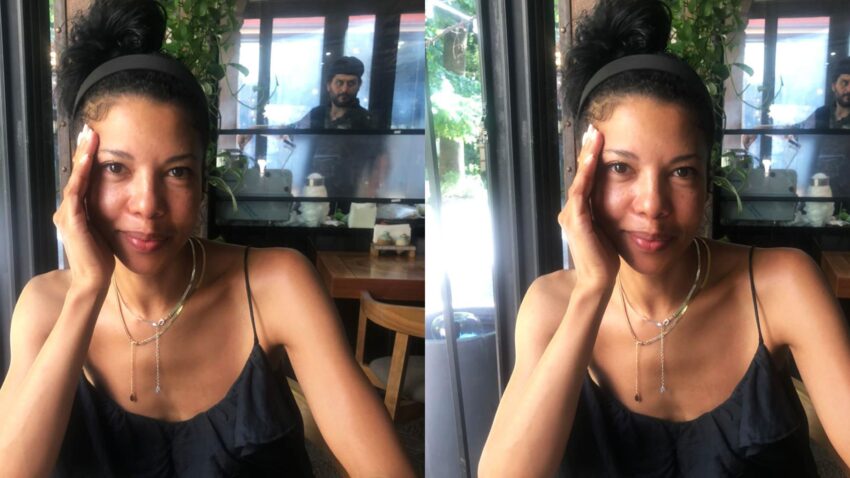
Casual Racism Still Plagues Post-Soviet Countries
“In an exclusive interview with The Daily Beast, famed Ukrainian television presenter and producer Karolina Ashion shared what she describes as the most painful moment of her career: when her former boss — then the director of Ukraine’s 1+1 media conglomerate and current Minister of Culture Alexander Tkachenko — allegedly told her that her appearance on a popular morning show would hurt the network’s ratings,” Anna Nemtsova wrote Friday, updated Sunday, for the Daily Beast.
“Ashion is a Black Ukrainian. Her father came to Leningrad, USSR, from Nigeria to study engineering. Even now, six years after the incident took place, Ashion is emotional talking about it, and struggles to find the words to describe her manager’s behavior.
“The presenter said the conversation with her then-boss began when she asked him why nobody would invite her to take part in the morning show’s broadcasts. She was working as an on-air talent at two weekly television shows at the time, but had a long-time dream to be featured in the major lifestyle program Snidanok z 1+1, the Ukrainian equivalent of Good Morning America.
“ ‘I remember Tkachenko telling me: “Have you seen yourself in the mirror? Our channel’s audience is not really… I am not ready to risk our ratings,” ‘ Ashion told The Daily Beast. After coming home the day of the encounter, Ashion told her husband about the conversation with her boss. ‘I cried in the kitchen and made the decision to quit my job,’ she told The Daily Beast. ‘Obviously it was impossible to stay.’

“But Ashion’s career did not freeze. She was offered positions with other television channels and primetime shows, and her popularity flourished. If not for a more recent incident, Ashion might have swallowed the pain in silence, as many people of color often do in post-Soviet countries and across Eastern Europe. But on June 26, the presenter said she ran into the minister and his wife in the city of Lviv, after attending a Chris Botti jazz concert.
“Instead of solving this problem easily by just shaking my hand and giving some friendly ‘Forgive me,’ minister Tkachenko said with a smirk: ‘What do you want from me now? An apology?’ Ashion claimed. ‘His comments sent me back to the six-year-old incident. The minister demonstrated his confidence. He felt right back then, and he has no shadow of doubt he is right now’ . . .”
Nemtsova also wrote, “Tkachenko refused to apologize and declined to address the issue, even as it became widely discussed in Ukraine. And then, this week, another racism scandal erupted when a Black Ukrainian, comedian Victor Vemun, spoke out [about] being invited to an openly racist show, Taras the Papuan, which has mocked Black people as ‘whites who’ve been burned over the fire.’
“Vemun and his sister rejected the offer. ‘For as long as they say from our country’s most popular stages that the color of our skin is just burnt white skin, Ukrainian parents will tell their kids, that we, black people, are black because we are burnt, smoked humans,’ Vemun said in his Instagram post captioned, ‘We plummet to new depths.’
“Casual racism has long plagued post-Soviet countries. ‘For a long, long time I’d [only] get invited to castings for porn star or Cuban stripper roles,’ Moscow movie actor Jean-Michel told The Daily Beast. ‘It is important to speak about this issue. I often notice that on seeing a Black guy… or a girl with big Afro hair, people can’t even fathom that the person was actually born in Russia.’. . .”
The “casual racism” has gone beyond insults and casting stereotypes. A Black American diplomat, not assigned to Ukraine, was attacked in Kiev in 2005 by a group of men in an apparent hate crime. The diplomat sustained minor injuries.
 Journal-isms asked then-Secretary of State Condoleezza Rice (pictured, 2019, by Michigan Daily) about the incident at a State Department briefing with the National Conference of Editorial Writers, now part of the News Leaders Association.
Journal-isms asked then-Secretary of State Condoleezza Rice (pictured, 2019, by Michigan Daily) about the incident at a State Department briefing with the National Conference of Editorial Writers, now part of the News Leaders Association.
“As soon as it happened we were in touch with the Ukrainian Government,” Rice said at the April 4, 2005, session. “I’ve talked to my own counterpart about it.
“Look, it’s a very ugly incident. It is not an unknown fact about Eastern Europe, the former Soviet Union, that this kind of behavior by skinheads, particularly against people of color, has been a problem in the past. This is an area of the world I know really well both as a specialist and as a person of color, and so I’m very aware of these problems.
“And the Ukrainian Government was deeply embarrassed by it, promised and I think is conducting a full investigation. They don’t want this sort of stain on their new democracy either. They’re dealing with really bad elements that have grown up in that part of the world over a long period of time. But they are not just aware of it; I think they really are trying to do something about it.”
- Cosmos Ojukwu, Business Ukraine: INTERVIEW: Afro-Ukrainian icon and TV personality Karolina Ashion on race and revolution (July 29, 2015)
- Kyler Ong and Raffaello Pantucci, Observer Research Foundation, India: From fringe to mainstream: The extreme rightwing in Europe (July 1, 2020)
- Liana Satenstein, Vogue: How Newscaster Karolina Ashion Is Shaking Up Kiev in Style (Nov. 17, 2016)
- Ukrainian Helsinki Human Rights Union: 184 crimes and only 4 convictions: what’s behind the hate crimes statistics in Ukraine (April 25, 2020)
Idris Diaz, Muslim Reporter, Later U.S. Envoy, Dies
 Idris M. Diaz, perhaps the first Muslim to write about taking part in the annual hajj to Mecca for a mainstream American newspaper, and who then went on to become a lawyer and State Department envoy, died July 22 of a rare stream of leukemia, his brother, Francisco Diaz, told Journal-isms Saturday. He was 61 and lived in the District of Columbia suburb of Bethesda, Md.
Idris M. Diaz, perhaps the first Muslim to write about taking part in the annual hajj to Mecca for a mainstream American newspaper, and who then went on to become a lawyer and State Department envoy, died July 22 of a rare stream of leukemia, his brother, Francisco Diaz, told Journal-isms Saturday. He was 61 and lived in the District of Columbia suburb of Bethesda, Md.
Diaz, a New York native and the son of a Black Honduran father and a mother from New Orleans, earned a master’s degree in journalism at Columbia University in 1983, then spent three and a half years at the Courier Journal in Louisville, Ky., and five at the Philadelphia Inquirer.
In his 1994 book, “American Jihad: Islam After Malcolm X” [PDF], Steven Barboza wrote that Diaz, who converted to Islam after having been raised Catholic, “found himself the sole representative of his faith wherever he has worked.
“As the staff expert, reporters and editors alike would call his home at all hours to ask for advice when covering news about Islam. The experience enlightened him about the media’s shortcomings in treating Islam knowledgeably and fairly.
“ ‘I think there’s just not the sensitivity in the portrayal of Muslims. Look at the World Trade Center bombing [of 1993],’ he says. ‘You see a spate of stories talking about Muslims as a threat. You don’t get a picture that there’s another side to the religion.’
“Diaz himself ended up writing the piece of his lifetime: covering his own hajj experience. He painted a picture of the scope of the annual hajj event for readers by asking them to imagine the entire population of Philadelphia descending on the city of Allentown for a few weeks’ stay. Entitled ‘For the Love of Allah,’ the piece made the cover of The Philadelphia Inquirer Magazine on April 2, 1989.”
Diaz wrote, “After it was published, I got tons of letters from Muslims and from non-Muslims. I got letters from people telling me they didn’t have much of a clear sense of what the religion was about until they read that. Muslims told me they were glad that my piece was out there. And I got a couple of letters from people telling me that I should burn in hell for putting out propaganda.”
Francisco (Frank) Diaz said his younger brother decided he “just wanted to do something else.” So, according to the family obituary, Diaz “graduated with honors from Howard Law School in1994, and worked briefly in corporate law at Arent Fox in Washington, D.C. But, as he’d long been fascinated with international affairs, he soon left to work at the U.S. Department of State on a legal team tasked with resolving international crises.
“From there, he joined the U.S. Agency for International Development (USAID), where, during his 15-year-tenure he rose through the ranks, working in a variety of posts at embassies in Dakar, Senegal; Kabul, Afghanistan; [and] Islamabad, Pakistan, culminating in his role as deputy mission director in New Delhi, India.
“At the time of his retirement from USAID in 2019, Diaz worked as the agency’s assistant general counsel for Africa, responsible for ensuring the $7 billion annual budget of USAID’s Africa Bureau was implemented in accordance with all applicable laws and regulations.
“Diaz was a student of diverse philosophies and religious faiths, a master of Aikido with a second-degree black belt, and an avid yoga practitioner who’d recently become a certified yoga teacher.”
Washington Post reporter Vanessa Williams messaged Journal-isms, “I worked and was friends with Idris back in Philly. He was smart, funny and just so chill, unflappable. I agree with the description in the remembrance that he had eclectic cultural tastes in food and music; he really did lean into exploring and appreciating different tastes and sounds.”
Survivors include his partner, journalist Marilyn Milloy. A memorial service is planned, perhaps in October, Frank Diaz said.
- Attorney Talib I. Karim and Dr. Nisa Muhammad, Academy of Muslim Achievement: Remembering our brother Idris
- USAID Alumni Association: In Memoriam — Recent Tributes
Short Takes
We, as Hmong people, have been so proud of Sunisa Lee.
We’ve also had some talented Hmong journalists documenting this history. There aren’t many of us, but holy crap we’re passionate.
I’m threading a few articles here you should check out. I promise they’re worth reading.
— Chenue Her (@ChenueHer) August 1, 2021
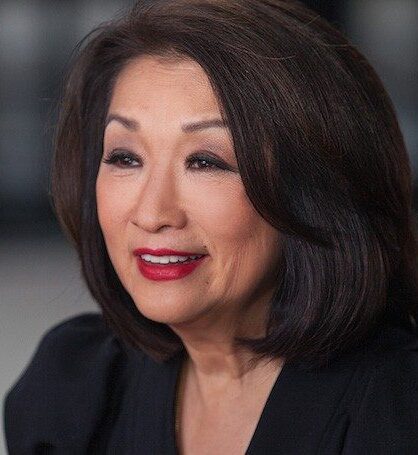 Connie Chung (pictured), the retired broadcast journalist, is among nine New Jerseyans who will have Garden State Parkway service areas bearing their names under a plan the New Jersey Turnpike Authority approved Tuesday, Colleen Wilson reported for NorthJersey.com. However, “Bruce Springsteen respectfully declined to have a service area named after him,” New Jersey Hall of Fame spokeswoman Natasha Alagarasan told Wilson. “It should be noted, though, that Bruce has been very supportive of the New Jersey Hall of Fame over the years, and is very much a part of the fabric of the Hall.” Chung’s 30-year career spanned broadcast (ABC, CBS, NBC) and cable (CNN, MSNBC). Dino Flammia, “a digital journalist for New Jersey 101.5FM,” dissented, asking, “Danny DeVito? What about Jack Nicholson? Bruce Willis? Jon Stewart? John Travolta? Meryl Streep?”
Connie Chung (pictured), the retired broadcast journalist, is among nine New Jerseyans who will have Garden State Parkway service areas bearing their names under a plan the New Jersey Turnpike Authority approved Tuesday, Colleen Wilson reported for NorthJersey.com. However, “Bruce Springsteen respectfully declined to have a service area named after him,” New Jersey Hall of Fame spokeswoman Natasha Alagarasan told Wilson. “It should be noted, though, that Bruce has been very supportive of the New Jersey Hall of Fame over the years, and is very much a part of the fabric of the Hall.” Chung’s 30-year career spanned broadcast (ABC, CBS, NBC) and cable (CNN, MSNBC). Dino Flammia, “a digital journalist for New Jersey 101.5FM,” dissented, asking, “Danny DeVito? What about Jack Nicholson? Bruce Willis? Jon Stewart? John Travolta? Meryl Streep?”
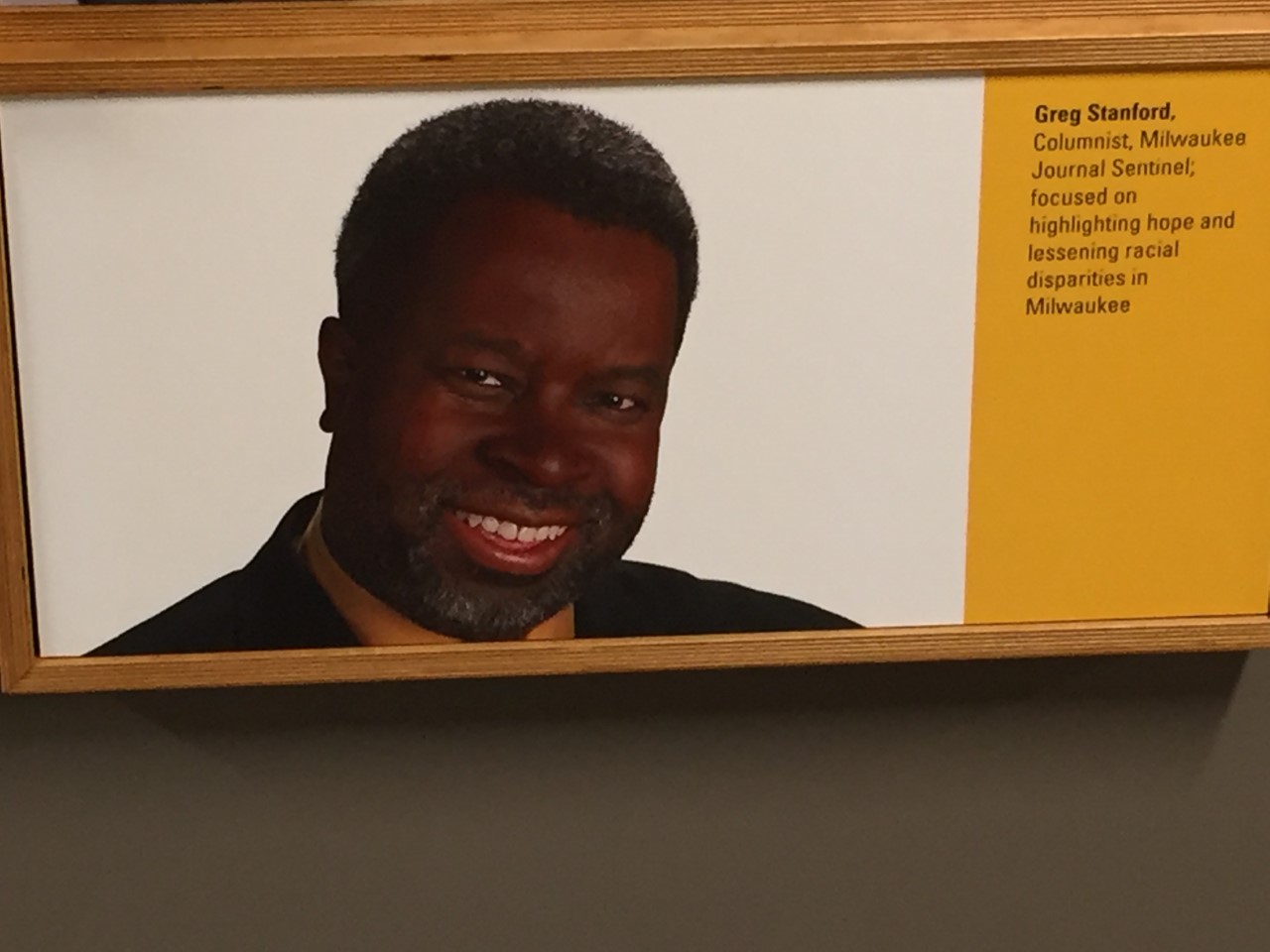 Greg Stanford, columnist for the Milwaukee Journal-Sentinel, who died in 2019, is now among notable Marquette University journalism and communication alumni pictured on the first floor of Johnston Hall at Marquette, reports Dave Umhoefer, director of the O’Brien Fellowship in Public Service Journalism at the university. Stanford was with the Milwaukee Journal and the Journal-Sentinel for 23 years, retiring in 2007 after having been an editorial writer and columnist since 1995. He maintained this website.
Greg Stanford, columnist for the Milwaukee Journal-Sentinel, who died in 2019, is now among notable Marquette University journalism and communication alumni pictured on the first floor of Johnston Hall at Marquette, reports Dave Umhoefer, director of the O’Brien Fellowship in Public Service Journalism at the university. Stanford was with the Milwaukee Journal and the Journal-Sentinel for 23 years, retiring in 2007 after having been an editorial writer and columnist since 1995. He maintained this website.
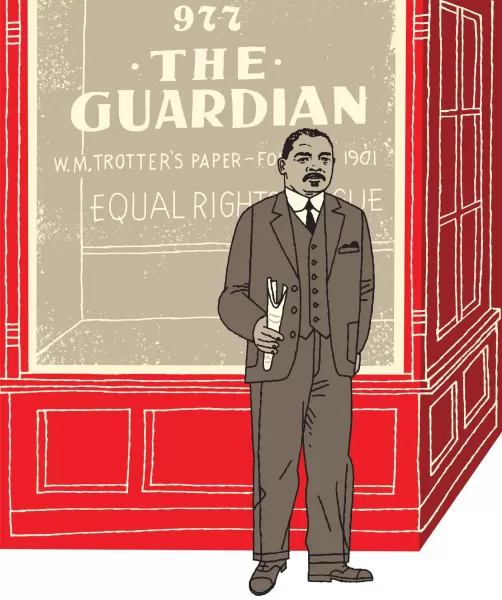
- William Monroe Trotter, the Black activist editor of the early 20th century who “rejected the view that racial equality could come in stages,” is part of a New Yorker issue on influential American news media figures.
To subscribe at no cost, please send an email to journal-isms+subscribe@groups.io and say who you are.
Facebook users: “Like” “Richard Prince’s Journal-isms” on Facebook.
Follow Richard Prince on Twitter @princeeditor
Richard Prince’s Journal-isms originates from Washington. It began in print before most of us knew what the internet was, and it would like to be referred to as a “column.” Any views expressed in the column are those of the person or organization quoted and not those of any other entity. Send tips, comments and concerns to Richard Prince at journal-isms+owner@
View previous columns (after Feb. 13, 2016).
View previous columns (before Feb. 13, 2016)
- Diversity’s Greatest Hits, 2018 (Jan. 4, 2019)
- Book Notes: Is Taking a Knee Really All That? (Dec. 20, 2018)
- Book Notes: Challenging ’45’ and Proudly Telling the Story (Dec. 18, 2018)
- Book Notes: Get Down With the Legends! (Dec. 11, 2018)
- Journalist Richard Prince w/Joe Madison (Sirius XM, April 18, 2018) (podcast)
- Richard Prince (journalist) (Wikipedia entry)
- February 2018 Podcast: Richard “Dick” Prince on the need for newsroom diversity (Gabriel Greschler, Student Press Law Center, Feb. 26, 2018)
- Diversity’s Greatest Hits, 2017 — Where Will They Take Us in the Year Ahead?
- Book Notes: Best Sellers, Uncovered Treasures, Overlooked History (Dec. 19, 2017)
- An advocate for diversity in the media is still pressing for representation, (Courtland Milloy, Washington Post, Nov. 28, 2017)
- Morgan Global Journalism Review: Journal-isms Journeys On (Aug. 31, 2017)
- Diversity’s Greatest Hits, 2016
- Book Notes: 16 Writers Dish About ‘Chelle,’ the First Lady
- Book Notes: From Coretta to Barack, and in Search of the Godfather
- Journal-isms’ Richard Prince Wants Your Ideas (FishbowlDC, Feb. 26, 2016)
- “JOURNAL-ISMS” IS LATEST TO BEAR BRUNT OF INDUSTRY’S ECONOMIC WOES (Feb. 19, 2016)
- Richard Prince with Charlayne Hunter-Gault,“PBS NewsHour,” “What stagnant diversity means for America’s newsrooms” (Dec. 15, 2015)
- Book Notes: Journalists Follow Their Passions
- Book Notes: Journalists Who Rocked Their World
- Book Notes: Hands Up! Read This!
- Book Notes: New Cosby Bio Looks Like a Best-Seller
- Journo-diversity advocate turns attention to Ezra Klein project (Erik Wemple, Washington Post, March 5, 2014)
When you shop @AmazonSmile, Amazon will make a donation to Journal-Isms Inc. https://t.co/OFkE3Gu0eK
— Richard Prince (@princeeditor) March 16, 2018

